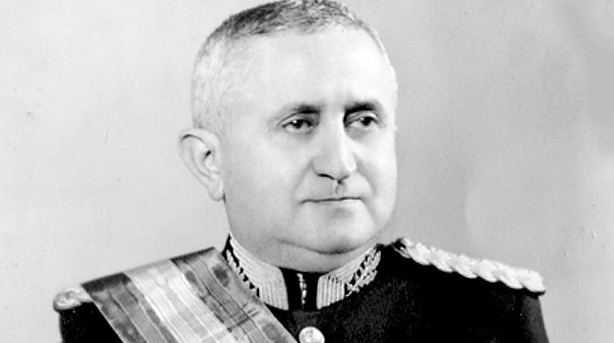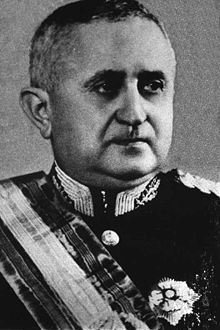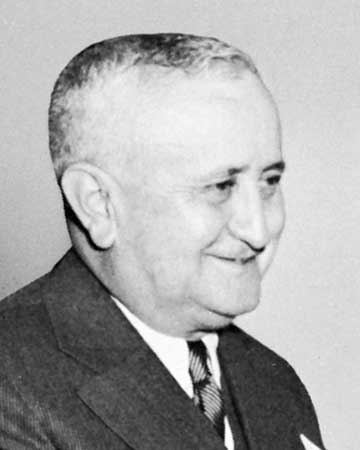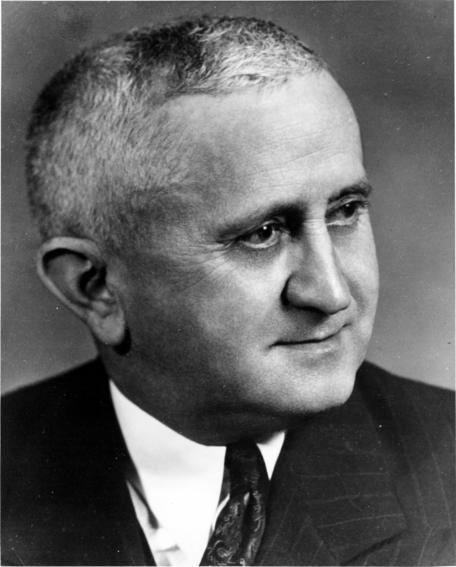Succeeded by Getulio Vargas Preceded by Ribeiro Filho Name Eurico Dutra Party Social Democratic Party | Preceded by Jose Linhares President Getulio Vargas Succeeded by Nereu Ramos Role Brazilian Politician | |
 | ||
Education Realengo Military School (1904–1906) Children Emelia Dutra, Antonio Dutra Parents Jose Florencio Dutra, Maria Justina Dutra Similar People Getulio Vargas, Cafe Filho, Janio Quadros, Juscelino Kubitschek, Carlos Lacerda | ||
Eurico Gaspar Dutra being sworn in as the new President of Brazil in Rio de Janei...HD Stock Footage
Eurico Gaspar Dutra ([ewˈɾiku ɡasˈpaɾ ˈdutra]; May 18, 1883 – June 11, 1974), was a Brazilian marshal, politician and President of Brazil from 1946 to 1951.
Contents
- Eurico Gaspar Dutra being sworn in as the new President of Brazil in Rio de JaneiHD Stock Footage
- Biography
- Minister of War
- 1945 Presidential election
- Presidency
- Later Life
- 1949 visit to the United States
- References

Biography

Military, born in Cuiaba, Mato Grosso. He later falsified his birth year to 1885, at age 19, so that he would have a physical compatible with the age, in order to facilitate his entry into the Army. He studied at the Preparatory and Tactical School of Rio Grande do Sul (1902-1904) and at the Military Academy of Brazil (Military School of ‘’Praia Vermelha’’ in Rio de Janeiro) in 1904, of which he was expelled for taking part in an uprising that same year, related to the Vaccine Revolt, but pardoned, returned to school, now based in Realengo, completing the course in 1906. He was also a student of the School of War in Porto Alegre (1906), the School of Artillery and Engineering, where perfected in mechanics, ballistics and metallurgy (1908-1910), and the School of General Staff, where he graduated as the 1st in class and received the rare mention "tres bien" (1922), acting shortly after, in the repression of the Sao Paulo Revolution of 1924.

Helped found the National Defense magazine in 1918, fought the uprising known as the "18 Fort" in 1922, in Rio de Janeiro, and participated, integrateing the North Detachment, under the command of General Mena Barreto, of the fighting against an insurgency erupted in Manaus that radiated to Para. By having fought the Revolution of 1930, he was sent to the command of the 11th Cavalry Independent Regiment in Ponta Pora.

Promoted to colonel, Dutra took command of the 4th Cavalry Divisional Regiment (1931-1933) in Tres Coracoes, where he fought the Constitutionalist Revolution in Sao Paulo in 1932. Defended the government of President Washington Luis against the rebels of 1930s, but already in 1932, fought the Constitutionalist Revolution in Sao Paulo. Appointed commander of the 1st Military Region (1935-1936), stood out in reaction to the communist movement in 1935, episode known as “Intentona Comunista”, occupying the post of Minister of War (1936-1945).
Minister of War

During World War II, he was among the Brazilian military leaders who were against an alignment with allies and a deeper involvement of the country in the conflict. With, although modest, Brazil's participation in the war on the Allied side, and the growing pressure from civil society for democratization of the country, Dutra formally adhered to the idea of the end of the regime that started in 1930, participating in the following deposition of Getulio Vargas in October 1945, continuing the interventionist doctrine, practiced at the time by the Brazilian army.
1945 Presidential election
In this context, the deposed leader announced the following month his support for Dutra, candidate of the Army, at the expense of the candidate of the Air Force, Eduardo Gomes, in the elections that followed.
Presidency
On September 18, 1946, the fifth constitution of Brazil was enacted, marking the country's return to democratic rule. That same year, the government created the Social Service of Industry (SESI) and Social Service of Commerce (SESC), and the General Staff, the future General Staff of the Armed Forces (EMFA). Still in 1946, the president ordered the closing of casinos and prohibited "gambling" in the country.
In 1947, he registered the appointment of Osvaldo Aranha delegate of Brazil to the United Nations (UN), the forfeiture of the Brazilian Communist Party (PCB), breaking off diplomatic relations with the Soviet Union (USSR) and achieved, in Petropolis, the Inter-American Conference of Peacekeeping and Security of the Continent, which was attended by the U.S. president, Harry Truman. Closer relations with the Americans, too, was evidenced in the formation of the Joint Commission Brazil-United States, known as Abbink Mission, headed by John Abbink and Minister Octavio Gouveia de Bouillon. Assignment was to diagnose the main problems of the Brazilian economy and, as a special recommendation, the use of external resources in the oil sector.
Still in 1947, saw the intervention of the Ministry of Labour in many unions, continuing the guardianship of the state over union activities guaranteed by ordinance in 9.070 of March 1946, a regulation which limited the right to strike.
Concomitant with the union repression and wage restraint, economic policy has gone through two phases: first, liberal, which sought to break with previous forms of intervention in the economy. However, imports of goods led to a rapid depletion of the country's foreign exchange reserves. In 1947, under the guidance of the International Monetary Fund (IMF) a second phase, in which the exchange control was retaken, kept the cruise at high levels compared to the U.S. currency. This policy discouraged exports, encouraging, on the other hand, the import of equipment, machinery and other inputs, excluding consumer goods, and favored the expansion of the manufacturing sector.
The development strategy of the government included the “Salte Plan”, named for an emphasis on Health, Food, Transportation and Energy. Proposed in 1947, it aimed at the management of public spending and investment in key sectors in the country but only began to receive funding from the budget in 1949, being forgotten in 1951. During this period measurements the country's economic growth by calculating the Gross Domestic Product (GDP) were first regularly published. The average annual growth of the Brazilian economy under his administration was 7.6%.
During the Dutra government construction of the hydroelectric plant of Paulo Afonso, Bahia, and the President Dutra highway linking Rio to Sao Paulo was initiated. In October 1948 his government set up the Superior School of War (ESG), with American support.
Later Life
Upon leaving the presidency, he remained active in politics until he ran again for president in the indirect elections for president of 1964. Facing a difficult election against military-backed General Castelo Branco, Dutra received only 0.54% of the vote.
He died away from public life in Rio de Janeiro on June 11, 1974, aged 91. His body was interned in the Sao Joao Batista Cemetery.
